All about dry felting
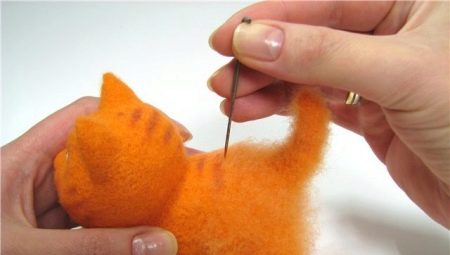
Dry felting as a type of handicraft is gaining more and more popularity. The result is most often very cute felt toys or woolen garment décor items. In this technique, you can also make beautiful original jewelry, for example, brooches or beads. And the methods of work are so simple that you can engage in this type of creativity even with children. You just need to take some precautions so as not to injure yourself on sharp tools.
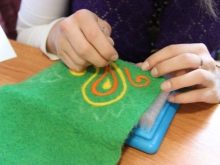
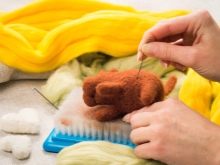
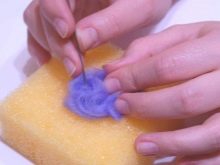
What is felting?
When they talk about felting, felt boots immediately come to mind and we begin to remember how they are rolled using water. So, the dry technique called felting or felting is radically different. The common thing is the material for work - fibers of pure wool, in both cases felt products are obtained. Large-scale surfaces are immediately processed only with wet felting, and felting allows you to make small forms with small details. The principle of felting is the entanglement of wool fibers with special needles through multiple punctures of the material.

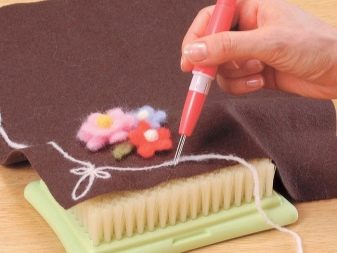
Tools and fixtures
Needles
The main tool for work is a needle, but a special one. With ordinary sewing, she is related only to the sharpness. And to complete one product, you may need a whole set. Needles differ in several ways:
- by thickness;
- by the shape of the section;
- in the direction of the teeth.
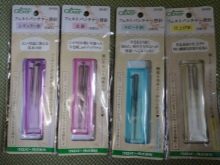
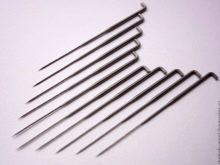
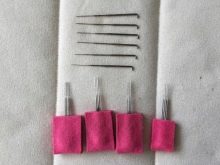
The needles are numbered depending on the thickness. The lower the number, the thicker the tool. The coarsest needles (No. 28, 30, 32) carry out the initial dumping of the material. For the final processing of products, thin needles (No. 38, 40) are used. At different stages of the process, tools with different sections are used. Most often required:
- triangular;
- "Star";
- "Crowns".
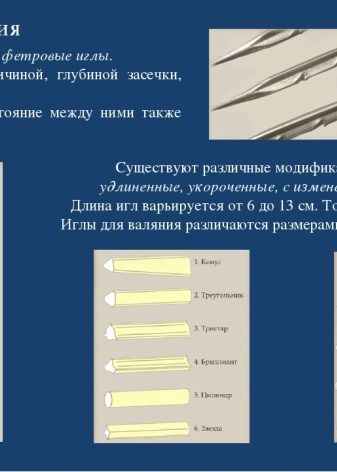

Almost all the main work can be done with triangular needles, gradually replacing thick ones with thinner ones. But they leave noticeable holes, which are smoothed out by "star" needles or "crowns". The most important element of the named tool is the teeth, they provide tangling of the wool fibers. Usually felted with needles with straight teeth. But when you need to create a fluffy surface, take the "reverse" needles, which hook and pull the fibers out.
Felting is a laborious process, so it is very important to choose a tool to work comfortably and as quickly as possible, especially if a large size product is being made. Creative people always strive to improve technology, and as a result, there is a fairly wide range of gadgets on the market.
There are needles with comfortable handles, but since different ones are required during the work, a holder with removable needles would be a more practical and cheaper option. There are devices in which several needles are fixed at once (for example, Clover or Gamma).
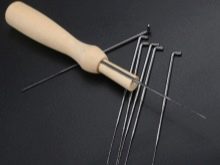
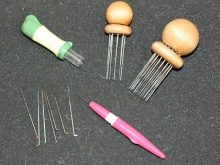

Felting machine
To make one felted product, you have to make countless punctures of the material. Especially enthusiastic needlewomen can greatly facilitate the work of a special machine for felting. However, there is currently no wide choice on the market.
Most often, online stores offer a German-made Addi Quick machine. 1 needle is fixed in it, punctures are made to a depth of 2-3 cm. The machine weighs about 600 grams. For comparison: the weight of any tool for repair work exceeds the specified one by at least 2 times. Of the shortcomings of the master, they distinguish a rather strong vibration during work, as well as the fact that the supplied needles are often not of very good quality. But according to their pattern, you can cut and use any commonly used needles.
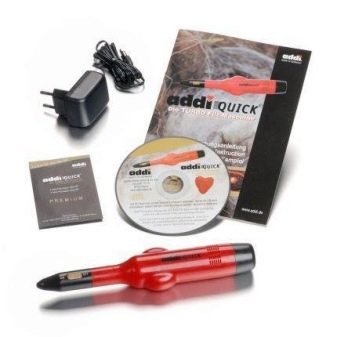
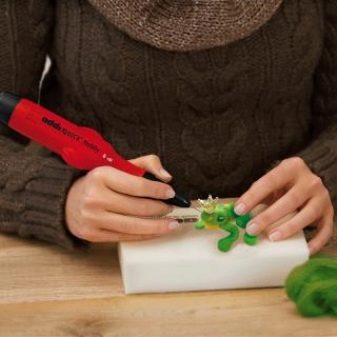
You can order a Simplisity car. It is 6-pin and has a protective shield. For safety of work, shutdown is provided when lifting the machine from the surface to be treated. You can often see homemade options, for example, from a children's sewing machine. Also, some people manage to fix the needles in technical tools, for example, in a jigsaw. But such experiments are still not safe.
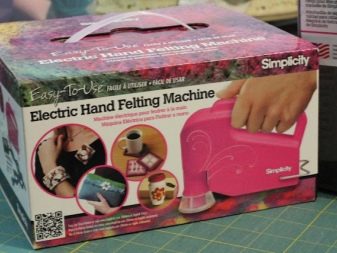
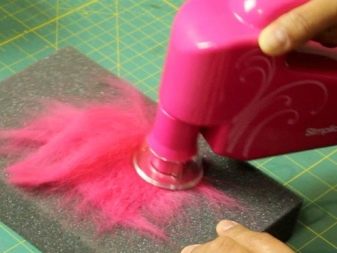
Base brush
Since in the process of felting the needle makes deep punctures, it is absolutely not recommended to roll through the entire part, holding the material in your hands or on your knees. It is best to do this with a special stiff brush with a heavy base.
If you cannot buy one for some reason, you can use polystyrene or foam rubber with a thickness of at least 3 cm.But the substrate made of such materials is unlikely to last long, and its pieces can get into the manufactured product, which will not improve the result at all.
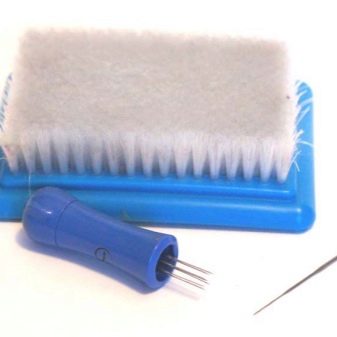
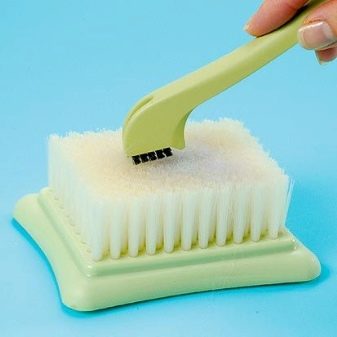
Comb-"slicker"
At the final stage of work, if you want to create a fluffy surface, you will need a comb. The needlewomen call her a slicker. You can use a stiff brush that is used to brush the animals.
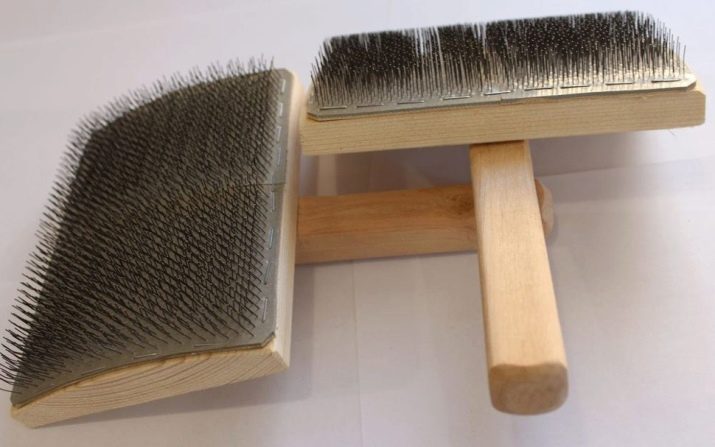
Material
Felted work is created exclusively from wool, but it can be different.
- Combed tape Is not spun wool, the fibers of which are laid in one direction. They can be of different colors and thicknesses. The tape with the finest fibers is used for finishing or felting small parts.
- Kardoches - wool with slightly matted fibers laid in different directions. Convenient to use, especially for large items.
- Sliver - coarse undyed wool, which is used for the inner warp of large parts. Products made entirely of colored high-quality material are quite expensive, and the use of a sliver reduces their cost.
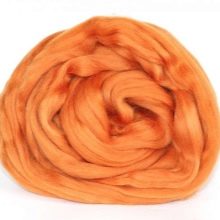
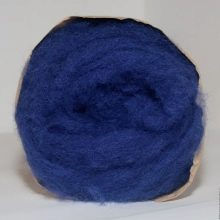
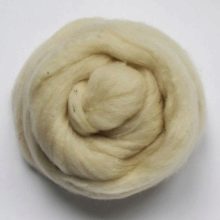
Sometimes the base is made of padding polyester, the end result does not worsen.But when a fluffy product is planned and with the help of a reverse needle the fibers will be pulled out from the inside, you need to make the top layer rather thick so that the base material does not appear on the outside.
Accessories and decor
When making toys, you will need additional parts. There are always eyes and noses for toy animals on sale. But you can make these elements with your own hands, for example, from polymer clay. Or embroider with woolen threads. For antennae, a fishing line is usually used. If you decide to make an original brooch or beads, then the accessories will also need to be bought in a specialized store.
To make the product more expressive, the final touches are applied with ordinary paints, most often acrylics. But beginners are advised to use pastel pencils. They are crushed and the resulting powder is spread over the woolen surface with a soft brush.
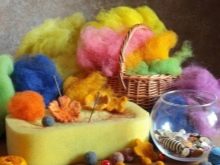
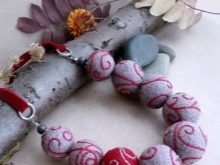
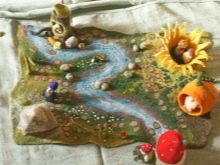
Step by step process
Step-by-step description of the process of felting a small toy as follows.
- When performing work, it is better to have a sample in front of your eyes, for example, a drawing, preferably from several angles. The ideal option is a volumetric model.
- You need to prepare tools and materials in advance. It is better to take needles, especially for beginners, with a margin, as they can break, and interrupting work and urgently running to the store will not be very pleasant. Decorations should also be purchased in advance.
- First, the largest details are performed, usually the torso and head. Strands of wool are pinched off the tape and laid in thin layers on the base. Each layer in a direction at right angles to the previous one. The volume of the prepared material should exceed the size of the future part by about 3-4 times.
- Then they begin to process the workpiece with needles. While the part is soft, use your fingers to shape it. The workpiece is constantly turned, making punctures evenly on all sides.
- On the head of the toy, eye sockets and other parts of the face or muzzles are formed when the animal is felting.
- When you need to make parts of the same size (for example, paws), layouts of an equal amount of wool are immediately prepared for them and alternately felted one or the other. If you completely dump the part, then lay out the strands for another, then they will turn out to be of different sizes.
- In order for the parts of the toy to be connected, the attachment points must be left a little loose. The parts are applied to each other and carefully processed with a needle. For a better connection, you can add fine strands of wool.
- When all the details are fastened, the surface is worked through with thin triangular and "star" needles. Small strands of wool can also be used for “sanding”.
- The toy is finished by adding small elements (eyes, nose, mustache, jewelry, etc.), then its surface is tinted.
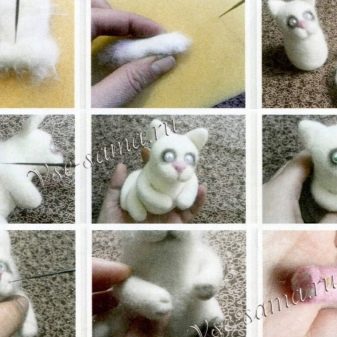
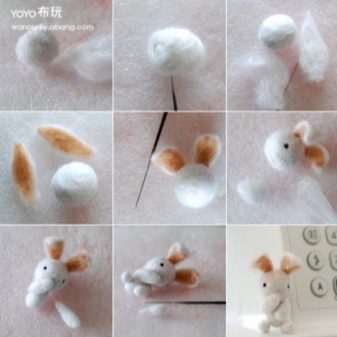
If you need to make long thin parts, a frame is used for their stability. Most often it is made from wire. Sometimes wool fibers are simply wound on such a base, smeared with PVA glue. The dry felting technique is also suitable for decorating knitwear. In this case, on the basis of the pattern, it is simply laid out with wool and processed with a needle.
Some details can be felted separately (just not to the final density), and then "nailed" them to the jersey. For a better result, it is recommended to roll the pattern with water and soap using the wet felting technique, so that it does not deform in the future during washing. But you still need to wash such products in a delicate mode in warm water.
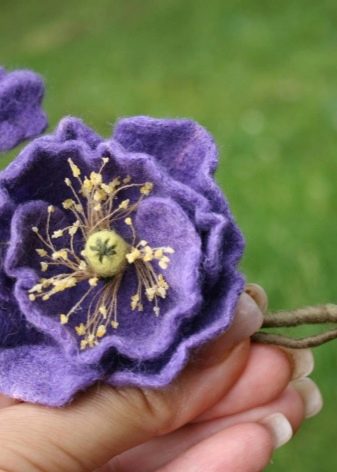

Tips & Tricks
To make your work comfortable and safe, and to make you happy with the result, it is worth listening to the advice of experienced craftsmen.
- It is impossible to work without a backing, and it is better to protect working fingers with thimbles.
- Try to pierce the started part to the middle so that it compresses inside. Otherwise, you can get a product with a dense surface, but very loose inside. Then it quickly deforms.
- The material should be pierced strictly in the vertical direction, otherwise the needle may break. It is necessary to process the entire surface evenly.
- The finished product should be firm to the touch so that no deformation occurs when pressed.
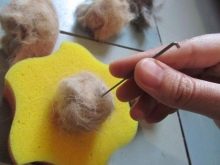

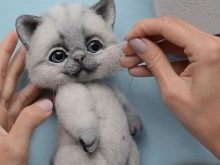
Each master has his own secrets. But mastery comes in the process of work. And if, listening to their recommendations, you put your imagination into creativity, then you can create your own woolen masterpieces.
For the basics of dry felting, see the next video.








